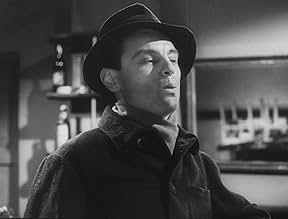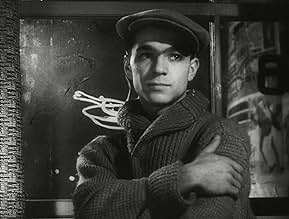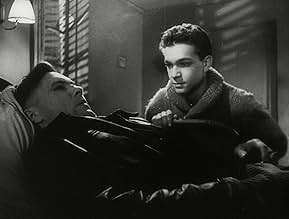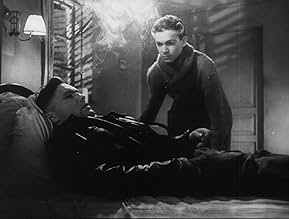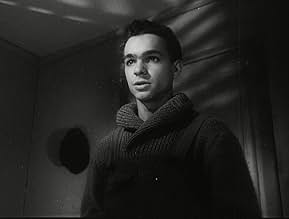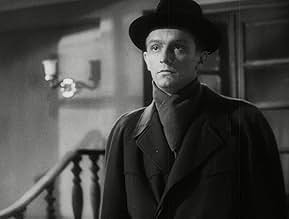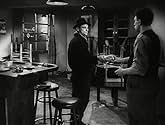Ubiytsy
- 1956
- 19 Min.
IMDb-BEWERTUNG
6,5/10
3943
IHRE BEWERTUNG
Füge eine Handlung in deiner Sprache hinzuTwo men besiege a lunch bar looking for a third man they must kill.Two men besiege a lunch bar looking for a third man they must kill.Two men besiege a lunch bar looking for a third man they must kill.
- Regie
- Drehbuch
- Hauptbesetzung
Empfohlene Bewertungen
This film is interesting for being what it is--a Soviet cinema school's student project depicting a Hemingway short story--one of the student performers being Andrei Tarkovsky. As a film on its own right, its acting and direction are uneven. That said, I thought some of the acting was fine. The mood is a bit too subdued and less menacing than the story as I remember it. Then again, the cast were all close to 20--so that's probably is to be expected. According to most accounts, this was the first project from the Soviet film school portraying a non Russian story--and this choice, which was freshly published at the time was chosen by the young Tarkovsky himself, 4.5 stars out of 10
Pure genius, though a short, it sends out images of poetry and passion. Seeing an early stage of formation of majestic artistry will astonish all who sees this film. Rich and powerful, it is an element that sends emotions through all who experience this inspired film.
For a class project in a cinema program this isn't bad at all, more of a reenactment of Hemingways's killer short story than a feature film. It takes about as long to watch it as it does to read the original story, with which I assume most of us are familiar.
The images are rather crude, the sets spare, and some of the acting is amateurish, although Aleksandr Gordon as George, the manager, is pretty good. He has the pock-marked sullen face that seems suitable to the role of the ordinary man in a frightening one-down position. The other notable performance is by Vasili Shukshin as Ole Anderson, the resigned victim awaiting his fate in a dumpy rooming house.
The movie follows the written story closely. In print, when Ole is visited by Nick Adams and, halfway through the conversation, rolls over and faces the wall, he does the same on film. We don't see much of Ole's room. I suppose the budget didn't allow for much display. But when Ole stubs out his cigarette on the wall next to his bed, we see that numerous other butts have been stubbed out in the same place and that tells us most of what we need to know.
The directors have made a few changes that don't interfere with the narrative in any way -- bits of business in which one of the killers flicks a few tiny objects off the counter top with his fingertip, that sort of thing.
The only jarring change is the virtual elimination of the role of Sam the black cook. It's too bad because this is in no way a funny story and Sam provides the few light-hearted moments.
No sign of directorial self display. It opens with a POV shot and there are one or two other slight surprises but it's not a Fourth of July fireworks by any means. It's functionally presented.
The English names of the characters is retained and on the café window we see that coffee costs "5 centes." I call it admirable fealty to the source, mistake and all.
What must it have been like, living in a nation in which Ernest Hemingway's work wasn't allowed to be published until 1956? But never mind literature -- can you imagine American movies without ten versions of "Crime and Punishment"? I'm waiting for a Hollywood blockbuster called "The Master and Margarita" starring Jude Law and Angelina Jolie.
The images are rather crude, the sets spare, and some of the acting is amateurish, although Aleksandr Gordon as George, the manager, is pretty good. He has the pock-marked sullen face that seems suitable to the role of the ordinary man in a frightening one-down position. The other notable performance is by Vasili Shukshin as Ole Anderson, the resigned victim awaiting his fate in a dumpy rooming house.
The movie follows the written story closely. In print, when Ole is visited by Nick Adams and, halfway through the conversation, rolls over and faces the wall, he does the same on film. We don't see much of Ole's room. I suppose the budget didn't allow for much display. But when Ole stubs out his cigarette on the wall next to his bed, we see that numerous other butts have been stubbed out in the same place and that tells us most of what we need to know.
The directors have made a few changes that don't interfere with the narrative in any way -- bits of business in which one of the killers flicks a few tiny objects off the counter top with his fingertip, that sort of thing.
The only jarring change is the virtual elimination of the role of Sam the black cook. It's too bad because this is in no way a funny story and Sam provides the few light-hearted moments.
No sign of directorial self display. It opens with a POV shot and there are one or two other slight surprises but it's not a Fourth of July fireworks by any means. It's functionally presented.
The English names of the characters is retained and on the café window we see that coffee costs "5 centes." I call it admirable fealty to the source, mistake and all.
What must it have been like, living in a nation in which Ernest Hemingway's work wasn't allowed to be published until 1956? But never mind literature -- can you imagine American movies without ten versions of "Crime and Punishment"? I'm waiting for a Hollywood blockbuster called "The Master and Margarita" starring Jude Law and Angelina Jolie.
Although I did like the 1946 adaptation of the Killers, I wasn't sure how a Russian, let alone someone who is usually much more into the visual prowess of things like Andrei Tarkovsky, would tackle Ernest Hemingway's brief, pulpy story of men on a mission and a man in hiding from those men. Turns out it's one of the best short films I've seen from a soon-to-be world renown European auteur, because of it's emphasis on the simplicity of suspense, of human action in desperate circumstances and how it's filmed with a mix of the noir style and with Tarkovsky's dependence on figures in curiously exciting compositions. He isn't alone on the film, however, as the middle scene at the apartment was directed by friend Alexander Gordon, with Tarkovsky directing the bigger chunks at the diner, and another guy Marika Beiku co-directing overall. Since the apartment scene is so short though, and accounts for just three shots, one being most elaborate as it goes in and out, tight and wide, on the morose Swede in hiding and his friend at the diner filling him in on what happened, it's mostly Tarkovsky's game here.
Part of the skill, and curiosity, in how tense the long first scene at the diner is that music is completely absent, with the only tone coming from Tarkovsky himself as a whistling customer. Meanwhile, Tarkovsky uses Hemingway's dialog in a very realistic manner, even when he goes deliberate angles, like when George goes into the back with the sandwiches and we see his feet in the same tilted frame as an empty can on the floor, or with the usage of the mirror on the wall. There's also the suddenness of seeing a machine gun that strikes things up in the room, and just the general attitude of Al and Max, the hit men, as they keep calling George "bright boy" in a way that reminds me of the curious double-talk in a self-consciously bad-ass movie like Pulp Fiction (not to mention the near casual usage of the 'N' bomb). While it ends sort of on a screeching halt, the sense of ambiguity as to the fate of the Swede as well as everyone else in the diner who hid the secret is worthwhile for the material, as it's perfectly anti-climactic. It's not entirely a simple experiment, as it's too polished for that, but I couldn't see how it could be made any longer either. It's perfectly paced and acted nearly as well, and it's a fitting pre-cursor to the un-prolific but remarkable career of one of Russia's most important filmmakers.
Part of the skill, and curiosity, in how tense the long first scene at the diner is that music is completely absent, with the only tone coming from Tarkovsky himself as a whistling customer. Meanwhile, Tarkovsky uses Hemingway's dialog in a very realistic manner, even when he goes deliberate angles, like when George goes into the back with the sandwiches and we see his feet in the same tilted frame as an empty can on the floor, or with the usage of the mirror on the wall. There's also the suddenness of seeing a machine gun that strikes things up in the room, and just the general attitude of Al and Max, the hit men, as they keep calling George "bright boy" in a way that reminds me of the curious double-talk in a self-consciously bad-ass movie like Pulp Fiction (not to mention the near casual usage of the 'N' bomb). While it ends sort of on a screeching halt, the sense of ambiguity as to the fate of the Swede as well as everyone else in the diner who hid the secret is worthwhile for the material, as it's perfectly anti-climactic. It's not entirely a simple experiment, as it's too polished for that, but I couldn't see how it could be made any longer either. It's perfectly paced and acted nearly as well, and it's a fitting pre-cursor to the un-prolific but remarkable career of one of Russia's most important filmmakers.
My Rating : 7/10
Excellent little short film in the film-noir realm from the Russian master of cinema. The minimalist nature of it is rather absurd but I think within it the viewer must find meaning and that is genius.
Solid short film-noir.
Excellent little short film in the film-noir realm from the Russian master of cinema. The minimalist nature of it is rather absurd but I think within it the viewer must find meaning and that is genius.
Solid short film-noir.
Wusstest du schon
- WissenswertesAll the roles were played by students of the VGIK. Moreover, props were not only brought by students from their homes, but also provided from friends and relatives.
- VerbindungenFeatured in Ein Tag im Leben des Andrej Arsenewitsch (1987)
- SoundtracksLullaby of Birdland
Written by George Shearing
(1952)
Whistled by the second bar patron played by Andrei Tarkovsky
Top-Auswahl
Melde dich zum Bewerten an und greife auf die Watchlist für personalisierte Empfehlungen zu.
Details
- Laufzeit
- 19 Min.
- Farbe
- Sound-Mix
- Seitenverhältnis
- 1.37 : 1
Zu dieser Seite beitragen
Bearbeitung vorschlagen oder fehlenden Inhalt hinzufügen

